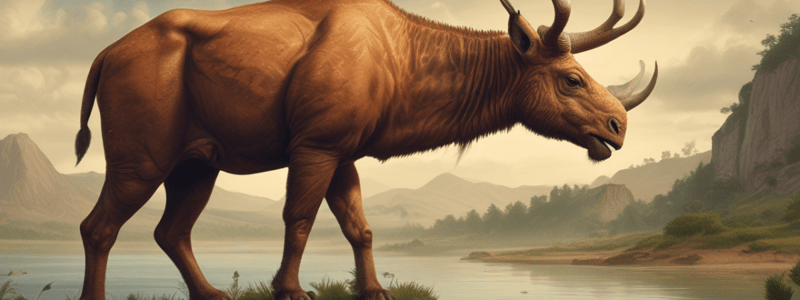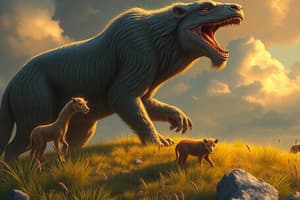Podcast
Questions and Answers
What is the goal of the quagga project?
What is the goal of the quagga project?
- To study the behavior of zebras
- To develop new breeds of cattle
- To create a new species of zebra
- To bring back the quagga (correct)
What was the outcome of the first attempt to bring back the aurochs?
What was the outcome of the first attempt to bring back the aurochs?
- A breed of cattle that differed significantly from the original aurochs (correct)
- A successful breed identical to the original aurochs
- A hybrid of cattle and another animal
- No results were obtained
Why did the Pyrenean ibex become extinct?
Why did the Pyrenean ibex become extinct?
- Due to climate change
- Due to overhunting (correct)
- Due to natural causes
- Due to habitat destruction
What is the current status of the passenger pigeon project?
What is the current status of the passenger pigeon project?
How many individuals are almost identical to the original quagga?
How many individuals are almost identical to the original quagga?
What is the goal of the Tauros Programme and the Taurus Project?
What is the goal of the Tauros Programme and the Taurus Project?
What was the outcome of the cloning experiment on Celia, the last Pyrenean ibex?
What was the outcome of the cloning experiment on Celia, the last Pyrenean ibex?
Why is cloning not a viable option for reviving the passenger pigeon?
Why is cloning not a viable option for reviving the passenger pigeon?
What is the planned timeline for releasing hybrids of the passenger pigeon into the wild?
What is the planned timeline for releasing hybrids of the passenger pigeon into the wild?
What is the purpose of bringing back the aurochs?
What is the purpose of bringing back the aurochs?
What is the estimated percentage of animals weighing over 100 pounds that went extinct in Australia after humans arrived?
What is the estimated percentage of animals weighing over 100 pounds that went extinct in Australia after humans arrived?
What is the name of the project that aims to bring back the quagga from extinction?
What is the name of the project that aims to bring back the quagga from extinction?
Where did the last quagga die in 1883?
Where did the last quagga die in 1883?
What is distinctive about the quagga's appearance?
What is distinctive about the quagga's appearance?
When was it suggested that quaggas could be re-bred via selective breeding?
When was it suggested that quaggas could be re-bred via selective breeding?
What was the major boost to the Quagga Project in 1980?
What was the major boost to the Quagga Project in 1980?
In which year did the Quagga Project start breeding quaggas in a specially constructed breeding camp farm?
In which year did the Quagga Project start breeding quaggas in a specially constructed breeding camp farm?
What was the outcome of human activity on the passenger pigeon, the moa, and the dodo?
What was the outcome of human activity on the passenger pigeon, the moa, and the dodo?
What was the common name for the thylacine?
What was the common name for the thylacine?
When was the thylacine officially protected by the Tasmanian government?
When was the thylacine officially protected by the Tasmanian government?
What is the estimated year for a full attempt to bring the thylacine back from extinction?
What is the estimated year for a full attempt to bring the thylacine back from extinction?
What is the species of elephant being considered for de-extinction?
What is the species of elephant being considered for de-extinction?
When did the woolly mammoth disappear?
When did the woolly mammoth disappear?
What is the proposed method to bring back the woolly mammoth through artificial insemination?
What is the proposed method to bring back the woolly mammoth through artificial insemination?
What is the percentage of neanderthal DNA in modern DNA outside of sub-Saharan Africa?
What is the percentage of neanderthal DNA in modern DNA outside of sub-Saharan Africa?
What is the estimated time when Homo sapiens and neanderthals last interbred?
What is the estimated time when Homo sapiens and neanderthals last interbred?
What is the common ancestor of Homo sapiens and neanderthals?
What is the common ancestor of Homo sapiens and neanderthals?
What is one of the characteristics that neanderthals and Homo sapiens share?
What is one of the characteristics that neanderthals and Homo sapiens share?
What is the primary reason for bringing back the aurochs?
What is the primary reason for bringing back the aurochs?
What is the main challenge in bringing back the Pyrenean ibex?
What is the main challenge in bringing back the Pyrenean ibex?
What is the goal of the Revive & Restore project?
What is the goal of the Revive & Restore project?
What is the current status of the quagga project?
What is the current status of the quagga project?
What is the focus of the Tauros Programme and the Taurus Project?
What is the focus of the Tauros Programme and the Taurus Project?
What happened to the last Pyrenean ibex, Celia?
What happened to the last Pyrenean ibex, Celia?
What is the main difference between the Heck cattle and the original aurochs?
What is the main difference between the Heck cattle and the original aurochs?
What is the expected outcome of the passenger pigeon project?
What is the expected outcome of the passenger pigeon project?
What is the purpose of the Uruz Project?
What is the purpose of the Uruz Project?
What is the significance of the quagga project?
What is the significance of the quagga project?
What is the primary reason why scientists believe that the quagga can be brought back from extinction?
What is the primary reason why scientists believe that the quagga can be brought back from extinction?
What is the estimated percentage of animals weighing over 100 pounds that went extinct in Australia after humans arrived?
What is the estimated percentage of animals weighing over 100 pounds that went extinct in Australia after humans arrived?
What is the primary driver of animal extinction in human history?
What is the primary driver of animal extinction in human history?
What is the significance of the 1980 research on mitochondrial DNA in the context of the quagga project?
What is the significance of the 1980 research on mitochondrial DNA in the context of the quagga project?
What is the approximate time frame during which the majority of megafauna extinctions occurred?
What is the approximate time frame during which the majority of megafauna extinctions occurred?
What is the primary goal of the Quagga Project?
What is the primary goal of the Quagga Project?
What is the common characteristic of the animals that went extinct in Australia after humans arrived?
What is the common characteristic of the animals that went extinct in Australia after humans arrived?
What is the significance of the Amsterdam Zoo in the context of the quagga?
What is the significance of the Amsterdam Zoo in the context of the quagga?
What is the primary reason why the Australian government's efforts to save the thylacine were unsuccessful?
What is the primary reason why the Australian government's efforts to save the thylacine were unsuccessful?
What is the significance of the sequencing of the thylacine's nuclear genome in 2017?
What is the significance of the sequencing of the thylacine's nuclear genome in 2017?
What is the proposed method to bring back the woolly mammoth through genetic engineering?
What is the proposed method to bring back the woolly mammoth through genetic engineering?
What is the estimated benefit of re-introducing the woolly mammoth to the environment?
What is the estimated benefit of re-introducing the woolly mammoth to the environment?
What is the relationship between Homo sapiens and neanderthals?
What is the relationship between Homo sapiens and neanderthals?
What is the percentage of neanderthal DNA in modern humans outside of sub-Saharan Africa?
What is the percentage of neanderthal DNA in modern humans outside of sub-Saharan Africa?
What is the significance of the neanderthal's extinction?
What is the significance of the neanderthal's extinction?
What is the estimated time frame for a full attempt to bring back the thylacine from extinction?
What is the estimated time frame for a full attempt to bring back the thylacine from extinction?
What is the primary difference between Homo sapiens and neanderthals?
What is the primary difference between Homo sapiens and neanderthals?
What is the significance of the Tasmanian government's declaration of the thylacine as an officially protected species in 1936?
What is the significance of the Tasmanian government's declaration of the thylacine as an officially protected species in 1936?
Flashcards are hidden until you start studying
Study Notes
Extinction and De-Extinction
- Human presence has led to the extinction of many animal species throughout history.
- Examples of extinct animals include the woolly mammoth, glyptodon, moa, passenger pigeon, and dodo.
Quagga
- The quagga was a subspecies of plains zebra that roamed the southern tip of Africa.
- It was hunted to extinction in the wild, and the last specimen died in 1883 in the Amsterdam Zoo.
- The Quagga Project aims to bring back the quagga through selective breeding of plains zebras with quagga-like traits.
Aurochs
- The aurochs was a massive species of cattle that was widespread across Eurasia, North Africa, and the Indian subcontinent during the Pleistocene era.
- The species was already reduced in numbers by the time human civilization began and became extinct in 1627.
- The Tauros Programme and the Taurus Project are attempting to revive the aurochs through selective breeding, while the Uruz Project by the True Nature Foundation wants to use genome editing.
Pyrenean Ibex
- The Pyrenean ibex is an extinct subspecies of the Spanish ibex that disappeared due to overhunting in the 19th and 20th centuries.
- In 1999, the last Pyrenean ibex, a female named Celia, was tagged and collared, and a tissue sample was taken from her.
- In 2003, scientists used the tissue sample to clone Celia, but the clone lived for only seven minutes due to a lung defect.
Passenger Pigeon
- Commercial hunting wiped out the passenger pigeon in the early 20th century.
- Revive & Restore, a conservation non-profit organization, is trying to bring back the passenger pigeon by identifying mutations in the DNA that cause phenotypic differences between the passenger pigeon and the band-tailed pigeon.
Thylacine (Tasmanian Tiger)
- The thylacine was a marsupial that once roamed over the Australian mainland, New Guinea, and Tasmania.
- The last known specimen, named Benjamin, died of neglect at the Hobart Zoo in 1936.
- In 2017, the full nuclear genome of the thylacine was sequenced, and a full attempt to bring the thylacine back from extinction could happen as early as 2027.
Woolly Mammoth
- The woolly mammoth is a species of elephant that disappeared around 1650 BCE.
- Research teams from countries such as Japan and Russia have been researching how the woolly mammoth could be resurrected through cloning, artificial insemination, or migrating genes from the mammoth genome into the genes of an Asian elephant.
Neanderthals
- Neanderthals are considered animals that could be candidates for de-extinction, although the ethical debates surrounding this are ongoing.
- Homo sapiens and neanderthals evolved from a common ancestor, likely Homo heidelbergensis, and interbred with our ancestors, leaving behind neanderthal DNA in modern humans.
Extinction and De-Extinction
- Human presence has led to the extinction of many animal species throughout history.
- Examples of extinct animals include the woolly mammoth, glyptodon, moa, passenger pigeon, and dodo.
Quagga
- The quagga was a subspecies of plains zebra that roamed the southern tip of Africa.
- It was hunted to extinction in the wild, and the last specimen died in 1883 in the Amsterdam Zoo.
- The Quagga Project aims to bring back the quagga through selective breeding of plains zebras with quagga-like traits.
Aurochs
- The aurochs was a massive species of cattle that was widespread across Eurasia, North Africa, and the Indian subcontinent during the Pleistocene era.
- The species was already reduced in numbers by the time human civilization began and became extinct in 1627.
- The Tauros Programme and the Taurus Project are attempting to revive the aurochs through selective breeding, while the Uruz Project by the True Nature Foundation wants to use genome editing.
Pyrenean Ibex
- The Pyrenean ibex is an extinct subspecies of the Spanish ibex that disappeared due to overhunting in the 19th and 20th centuries.
- In 1999, the last Pyrenean ibex, a female named Celia, was tagged and collared, and a tissue sample was taken from her.
- In 2003, scientists used the tissue sample to clone Celia, but the clone lived for only seven minutes due to a lung defect.
Passenger Pigeon
- Commercial hunting wiped out the passenger pigeon in the early 20th century.
- Revive & Restore, a conservation non-profit organization, is trying to bring back the passenger pigeon by identifying mutations in the DNA that cause phenotypic differences between the passenger pigeon and the band-tailed pigeon.
Thylacine (Tasmanian Tiger)
- The thylacine was a marsupial that once roamed over the Australian mainland, New Guinea, and Tasmania.
- The last known specimen, named Benjamin, died of neglect at the Hobart Zoo in 1936.
- In 2017, the full nuclear genome of the thylacine was sequenced, and a full attempt to bring the thylacine back from extinction could happen as early as 2027.
Woolly Mammoth
- The woolly mammoth is a species of elephant that disappeared around 1650 BCE.
- Research teams from countries such as Japan and Russia have been researching how the woolly mammoth could be resurrected through cloning, artificial insemination, or migrating genes from the mammoth genome into the genes of an Asian elephant.
Neanderthals
- Neanderthals are considered animals that could be candidates for de-extinction, although the ethical debates surrounding this are ongoing.
- Homo sapiens and neanderthals evolved from a common ancestor, likely Homo heidelbergensis, and interbred with our ancestors, leaving behind neanderthal DNA in modern humans.
Studying That Suits You
Use AI to generate personalized quizzes and flashcards to suit your learning preferences.




